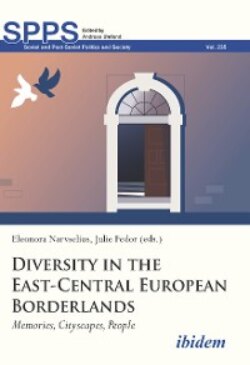Читать книгу Diversity in the East-Central European Borderlands - Группа авторов - Страница 31
На сайте Литреса книга снята с продажи.
Comparison between the Four Cities Memories Reflected in the Built Structure and Urban Environment
ОглавлениеAll four cities underwent a period of prosperous development in the interwar years, accompanied by the breakthrough of modern architecture. Wartime destruction was most extensive in Wrocław/Breslau and Chişinău, up to 60–70%. In L’viv/Lwów, some resident and industrial areas were damaged, but mostly, the city was well preserved. Chernivtsi/Cernăuţi was least affected by wartime destruction.
Cernăuţi and Chişinău had both a division between a poorer, old “lower town” and a better-off newer “upper town.” Jews lived in both districts, depending on their economic circumstances. The “lower towns” had small-scale buildings mostly associated with Jewish small craftsmen, merchants, innkeepers, and teachers. The north-west districts of Lwów had a similar ethnic and social structure. The World War II ghettos were located in these areas. In Chişinău, only minor parts of the “lower town” are still preserved. The more representative “upper towns” reflected the leading commercial, financial, academic, and cultural layers, in Cernăuţi dominated by emancipated Jews. In Lwów, the more affluent districts around Legionów, Akademicka, Jagiellońska, and Leona Sapiehy Streets96 had a mixed Polish and emancipated Jewish character. In other lower- and middle-class districts, including suburbs, the ethnicities were rather mixed. In Breslau, the differences between urban districts were more social than ethnic, but there was a concentration of Jews in the district around Wallstraße, and north of the river Oder lived many Poles.
In present-day L’viv and Chernivtsi, urban history has a prominent role. In L’viv, the emphasis is placed more on Ukrainian than Polish culture and history. Major monuments of architecture from the Austrian period are well accentuated, but more connected with the general city culture than with Austrian power. The situation differs in Chernivtsi, where since 1991 the Austrian period has been regarded as a golden age, reflected in the most important and admired streets, places, and also nostalgic cafés and restaurants. The focus is more on the city’s artistic milieu and the “Czernowitz spirit,” than on specific ethnic groups. In the UNESCO discussions in 2004–2010, the architecture of the former Metropolitan Residence was regarded as reflecting the city’s multi-ethnic character. In Chernivtsi itself, Ukrainians and Jews attract more interest than other nationalities, but an increasing amount of attention is also paid to the Romanian period and its architecture. The post-Soviet library and research center Bukowina-Zentrum at the university, now closed, played an important role in exploring Chernivtsi’s multi-ethnic heritage.
Although historical Lwów is mainly Polish, guidebooks, popular historical literature and inventories do not explicitly accentuate Polish culture and history. Interwar modernist buildings are presented more as an expression of their time than as elements of Polish heritage. This practice could indicate a desire not to bring into question the belonging of L’viv to Ukraine. Perhaps for similar reasons, it is rare for distinctions to be drawn between the Moldovan (Romanian) and the Russian in descriptions of old buildings and the city environment in Chişinău. In Chernivtsi, a focus on Austrian heritage, which is no longer “dangerous,” makes it possible to avoid more difficult discussions of relations between Romanians and Ukrainians. Nevertheless, numerous memorial plaques also commemorate Romanians.
The old built environment of Wrocław comprises first and foremost German and German-Jewish heritage. Although the postwar population of Breslau/Wrocław almost totally lacked historical connections, the historical town was well reconstructed after wartime damage. This reconstruction of German heritage, although legitimized by a certain linkage to Polish history, may reflect an appreciation of the old built environment as such, independent of its history. The UNESCO World Heritage site of Centennial Hall is highlighted, but mostly as purely architectural heritage. However, recently German culture as such has begun to be recovered in books and reprinted photos and maps. The exhibition of Nobel Prize winners also partly implies recognition of the German heritage. The heritage of the Jews is well-integrated into the present-day story of the city.
In recent years Jewish heritage is highlighted in all four cities, although somewhat less in Chişinău. Everyday life, such as old shops, cafés, restaurants, and other establishments are recollected in books, old photos, and postcards, and, with the exception of Chişinău, old address books have been uploaded to the Internet.
